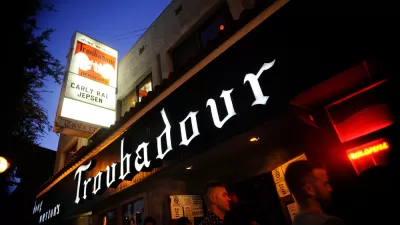Two well-known Los Angeles civic leaders advocate a new framework for understanding the built environment and landscape of Los Angeles, setting a trajectory for sustainable development.
Los Angeles’ urbanism is difficult to unravel, characterized typically as suburban, messy, and poorly planned. But how can we understand its origins and where the city is moving today? How does the landscape of Los Angeles come to define its trajectory? Two of LA’s prominent civic leaders—Daniel Rosenfeld, President of The George Crenshaw Development Project, and Paul Vandeventer, President & CEO of Community Partners—have created a framework in the following The Planning Report article to anchor the city’s physical timeline. Their observations offer insight into what they call a “Fifth Covenant” between Angelenos and the land, setting the stage for sustainable growth.
A convenant? Vandeventer and Rosenfeld respond, "Throughout history, every community has served as a steward for the land it inhabits. The people of Los Angeles are no different. Their stewardship not only continues a covenant handed down from previous generations, but also represents a commitment to future Angelenos. A covenant with the land suggests a shared conviction across generations that responsibly managing the land matters. Stewardship means both knowledge of the past and wisdom inform decisions that shape the future. We’ve created something remarkable in Los Angeles despite wavering in our stewardship over the decades between the poles of mastery and drift."
An appreciation for urban living coupled with investment in a growing mass transit system and a revitalized Downtown mark signs of this new covenant. As Los Angeles evolves over the next century, residents, businesses, and community stakeholders have an opportunity to recommit themselves to their city and to the environment.
FULL STORY: Advocating a New Planning Covenant for Los Angeles

Alabama: Trump Terminates Settlements for Black Communities Harmed By Raw Sewage
Trump deemed the landmark civil rights agreement “illegal DEI and environmental justice policy.”

Study: Maui’s Plan to Convert Vacation Rentals to Long-Term Housing Could Cause Nearly $1 Billion Economic Loss
The plan would reduce visitor accommodation by 25% resulting in 1,900 jobs lost.

Planetizen Federal Action Tracker
A weekly monitor of how Trump’s orders and actions are impacting planners and planning in America.

Waymo Gets Permission to Map SF’s Market Street
If allowed to operate on the traffic-restricted street, Waymo’s autonomous taxis would have a leg up over ride-hailing competitors — and counter the city’s efforts to grow bike and pedestrian on the thoroughfare.

Parklet Symposium Highlights the Success of Shared Spaces
Parklets got a boost during the Covid-19 pandemic, when the concept was translated to outdoor dining programs that offered restaurants a lifeline during the shutdown.

Federal Homelessness Agency Places Entire Staff on Leave
The U.S. Interagency Council on Homelessness is the only federal agency dedicated to preventing and ending homelessness.
Urban Design for Planners 1: Software Tools
This six-course series explores essential urban design concepts using open source software and equips planners with the tools they need to participate fully in the urban design process.
Planning for Universal Design
Learn the tools for implementing Universal Design in planning regulations.
Caltrans
Smith Gee Studio
Institute for Housing and Urban Development Studies (IHS)
City of Grandview
Harvard GSD Executive Education
Toledo-Lucas County Plan Commissions
Salt Lake City
NYU Wagner Graduate School of Public Service




























